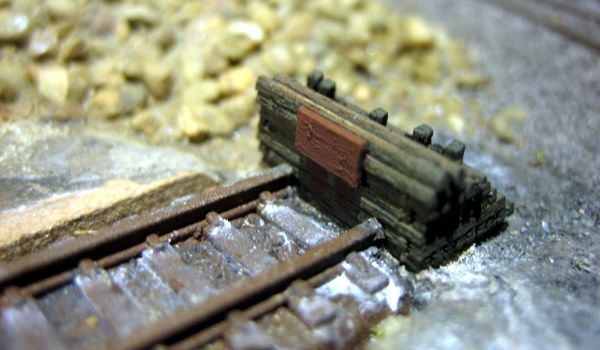No Clearance
It started with the factory, Central Valley Model Works. Pleased with the new arrangement of the industrial siding, I took action and permanently affixed the building in place on the layout. To maximize the foreground space, I positioned it as close to the siding as clearances would allow—the freight doors along the track were designed with this in mind. As a result, it called for a little detail: a "No Clearance" sign on the corner of the building adjacent to the track.

It was a simple enough thing: I just rendered it in a drawing program, printed it in high resolution on white decal paper, and applied it to the building. What followed was a flurry of detailing that included a skylight and a collection of rusty, unidentified drums tucked away behind the building—surely a future mini-superfund site in the making. The drums were made for N Scale, but being isolated at the end of the building, their slightly excessive size goes unnoticed.

Next I tackled the remaining tasks for the fuel depot across from the factory. It was already well along, and only needed a catwalk and some plumbing. The catwalk is comprised of a scrap of N Scale freight car roofwalk, a pair of supports made from brass fret material, railing from a ship detailing kit, and a ladder left over from a fire escape, all soldered together. Plumbing, as such, was just a few bits of brass wire here and there to suggest things were functional. Meanwhile, the little office—originally a tool shed—got a coat of primer and some colored chalk finish work. I'm still debating whether or not to make a sign for it, and if so, what to name the business; perhaps Owens-Parks Fuel Oil might be appropriate, since it retains the identity of the lumber yard it essentially replaced. (Do I think about this stuff too much?)

The siding itself got a bumper (as did the other three sidings) courtesy of GCLaser kit #5182. My version is slightly modified: I reduced it by one layer in height—it's just a tad too tall otherwise—and I added a striker plate made from a scrap of lazerboard. All of which is to say that the industrial siding is done. Of course, "done" is a relative term; there are a few things still to come, including the road surfaces, grade crossing and some vehicles. At any rate, it's interesting to compare the final outcome with how I'd envisioned it back in early February. This blog certainly provides good insight into my singular modeling process!
